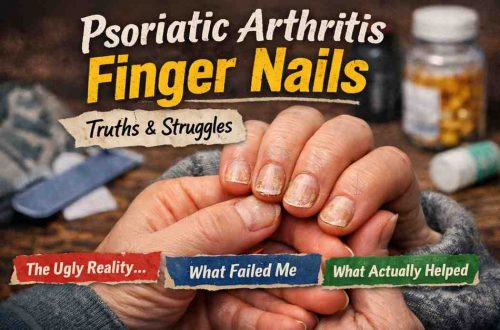
Psoriatic Arthritis Finger Nails: 7 Brutal Truths I Learned the Hard Way (and One That Gave Me Hope)
Honestly… I didn’t even know psoriatic arthritis finger nails were a thing at first.
I just thought my nails were “going bad.”
Peeling. Pitting. Lifting off the nail bed like they were slowly quitting on me. Some mornings I’d wake up, look at my hands, and feel this weird mix of embarrassment and panic. Like — is this normal? Did I do something wrong? Is this permanent?
Not gonna lie, I hid my hands a lot that year. Hoodie sleeves. Pockets. Avoiding eye contact when paying at stores. Small stuff like that adds up fast.
This isn’t a medical textbook explanation. This is what it felt like to live inside it. Messy, frustrating, confusing, and slowly… manageable.
If you’re here because your fingernails are doing things nails absolutely shouldn’t be doing — yeah. I get it.
How I Realized My Nails Weren’t Just “Ugly” or “Weak”
At first, I blamed everything except my body.
-
Too much hand sanitizer
-
Cheap nail clippers
-
A bad manicure years ago (seriously)
-
Stress
-
“Probably a vitamin thing”
I bought supplements. Biotin gummies. Fancy cuticle oils I never used consistently. Nothing changed.
Then the pits showed up. Tiny dents like someone pressed a pin into wet clay. Then the discoloration. Then pain — not constant, but sharp enough to make me drop things.
What honestly surprised me?
My joints weren’t even that bad yet.
The nails showed up first. And they were loud about it.
That’s when my rheumatologist finally said the words I didn’t expect to hear tied to fingernails. And suddenly everything clicked in the worst way.
The Part No One Warned Me About: Nails Mess With Your Head
This might sound dramatic. But nails are visible all the time.
Typing. Shaking hands. Holding a coffee. Scrolling your phone. They’re always there, reminding you something’s off.
For me, the emotional stuff hit before the physical pain:
-
Embarrassment
-
Feeling “dirty” even though I wasn’t
-
Constant comparison to other people’s hands
-
Avoiding photos
I didn’t expect that at all. I thought I was tougher than that.
Turns out, chronic stuff doesn’t need to be loud to mess with you.
What I Completely Misunderstood at First
Here’s where I messed this up early.
I treated nail symptoms like a surface problem.
Topicals only. Nail strengtheners. Buffing. Filing more aggressively (bad idea). Covering damage instead of understanding it.
I kept thinking, If I fix the nail, the problem goes away.
Wrong direction.
From what I’ve seen, at least — nails in psoriatic arthritis behave more like a signal, not the disease itself. They flare when inflammation’s active elsewhere, even if you can’t feel it yet.
That realization sucked. But it also helped me stop chasing quick fixes.
The Stuff That Flat-Out Didn’t Work for Me
I’ll save you some time (and money).
Things I tried that did basically nothing:
-
Hard-as-armor nail strengtheners (made cracking worse)
-
Daily buffing (thinned the nails fast)
-
Cutting nails super short (hurt when beds were tender)
-
Ignoring it and “waiting it out” (wishful thinking)
I’m not saying these never work. Just… for me? Nope.
And I wish someone had told me earlier that nail changes don’t respond on the same timeline as skin.
Nails are slow. Painfully slow.
What Actually Started Helping (Not Overnight, Though)
This is where things shifted. Not magically. Gradually.
1. Treating Inflammation First, Not Nails
Once my overall treatment stabilized, my nails stopped worsening. That alone felt like a win.
They didn’t improve fast. But they stopped spiraling.
That mattered more than I expected.
2. Changing How I Used My Hands
Sounds silly. It’s not.
-
Gloves for dishes (every time)
-
No bare-hand cleaning products
-
Gentle soap only
-
Pat dry, never rub
Small stuff. Big difference over months.
3. Oil > Cream (This One Surprised Me)
Creams sat on top. Oils actually soaked in.
I kept it boring:
-
Plain jojoba
-
Vitamin E when things cracked
No fragrance. No hype. Just consistency.
Timeline Reality Check (This Was Hard to Accept)
Here’s the honest answer to “how long did it take?”
Too long.
-
2–3 months: less splitting
-
4–6 months: new growth looked healthier
-
9+ months: nails that didn’t immediately scream “something’s wrong”
That’s with treatment and care.
Anyone promising instant nail recovery? I’d be skeptical.
Nails grow slow. Healing them is a patience test you didn’t sign up for.
The Pain Factor Nobody Explains Well
It’s not always pain like a broken bone.
It’s:
-
Tender nail beds
-
Random sharp zings
-
Pressure sensitivity
-
That awful feeling when a nail lifts just enough to catch on fabric
Some days were fine. Others were… irritating enough to ruin my mood.
Learning to protect instead of “push through” helped more than I want to admit.
What If Yours Don’t Improve? (Because That’s a Real Fear)
I worried about this constantly.
Here’s what I learned the hard way:
-
Nail response ≠ treatment failure
-
Some nails lag behind everything else
-
Stress flares nails faster than joints (for me)
I stopped using my nails as the only measure of progress. That mental shift mattered.
Would I still prefer normal nails? Obviously.
But obsessing made everything worse.
Things I’d Tell Past Me (So You Don’t Have To Learn the Same Way)
If I could go back, I’d say:
-
Stop blaming yourself
-
Stop over-treating the nail surface
-
Track patterns, not perfection
-
Protect your hands like they matter (because they do)
-
Ask questions early — don’t minimize nail symptoms
And maybe most important:
You’re not vain for caring about your hands.
This stuff affects real life.
Practical Takeaways (No Fluff)
If you want the condensed version:
-
Nails reflect inflammation, not just damage
-
Gentle care beats aggressive fixing
-
Oils > hardeners for fragile nails
-
Improvement takes months, not weeks
-
Emotional impact is real — don’t dismiss it
No guarantees. No miracle claims. Just what held true for me.
I won’t say psoriatic arthritis finger nails ever stopped being annoying. They didn’t.
But they stopped controlling how I felt about myself.
And that was the bigger win.
So if you’re staring at your hands right now, feeling confused or frustrated or weirdly ashamed — yeah. You’re not alone in that.
This isn’t magic.
It’s slow.
It’s imperfect.
But for me?
It finally made things feel… manageable.




